The Economics and Statistics Division maintains archives of previous publications for accountability purposes, but makes no updates to keep these documents current with the latest data revisions from Statistics Canada. As a result, information in older documents may not be accurate. Please exercise caution when referring to older documents. For the latest information and historical data, please contact the individual listed to the right.
<--- Return to Archive
For additional information relating to this article, please contact:
January 05, 2024LABOUR FORCE SURVEY: VISIBLE MINORITIES, DECEMBER AND ANNUAL 2023 The Labour Force Survey asks respondents about whether they identify with visible minority categories (as used in the Census): White, South Asian (e.g., East Indian, Pakistani, Sri Lankan), Chinese, Black, Filipino, Arab, Latin American, Southeast Asian (e.g., Vietnamese, Cambodian, Laotian, Thai), West Asian (e.g., Iranian, Afghan), Korean, Other.
December 2023 (3 month moving average, unadjusted)
Nationally, the unemployment rate for those who identify as a visible minority population (7.1%) was higher than the unemployment rate (4.6%) for those that did not identify as Indigenous or in a visible minority population. All regions had unemployment rate higher for those who identify with a visible minority group than for those who did not identify as Indigenous or in a visible minority population. This gap was highest in Quebec while the lowest gaps were in British Columbia and Alberta. In Atlantic Canada, the unemployment rate was 8.4% for those that identify with a visible minority group, and 6.6% for those that did not identify as Indigenous or in a visible minority population.
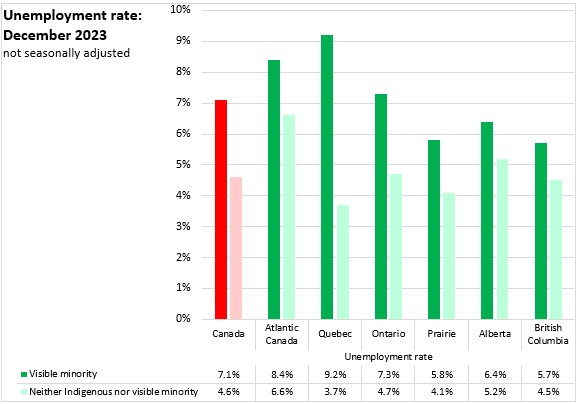
National participation rates were higher for those who identify with a visible minority population (70.5%) than for those that did not identify as Indigenous or in a visible minority population (63.0%). Participation rates of those who identify with a visible minority population were higher in all regions in December. In Atlantic Canada, those who identify with a visible minority population reported a 76.7% participation rate, compared to a 59.3% participation rate for those that do not identify as Indigenous or in a visible minority population.
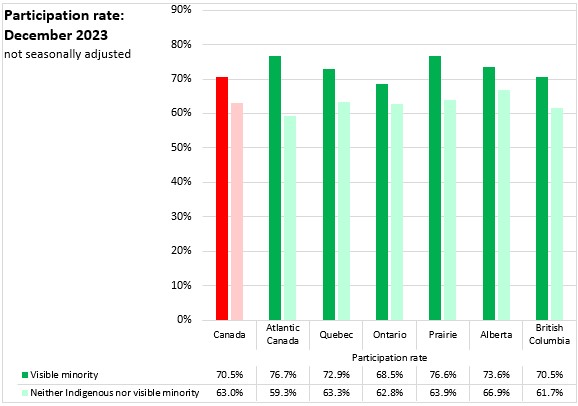
Nationally, employment rates were higher for those who identified with visible minority populations (65.5%) than for those who did not identify as Indigenous or in a visible minority population (60.1%). Employment rates were higher for those who identify with visible minority populations in every region when compared against those who do not identify as Indigenous or in a visible minority population in November. The gap between the employment rates for those who identified with visible minority populations (70.3%) and those who did not (55.4%) was highest in Atlantic Canada.
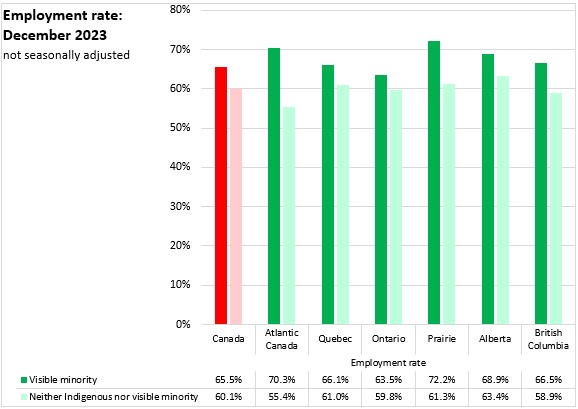
Canada's unemployment rates were generally higher across visible minority populations than for those who did not identify as Indigenous or in a visible minority population (exceptions: Japanese, Korean and Filipino populations). Unemployment rates of females in specific visible minority populations were typically higher than unemployment rates among males (exceptions: Black, Filipino populations).
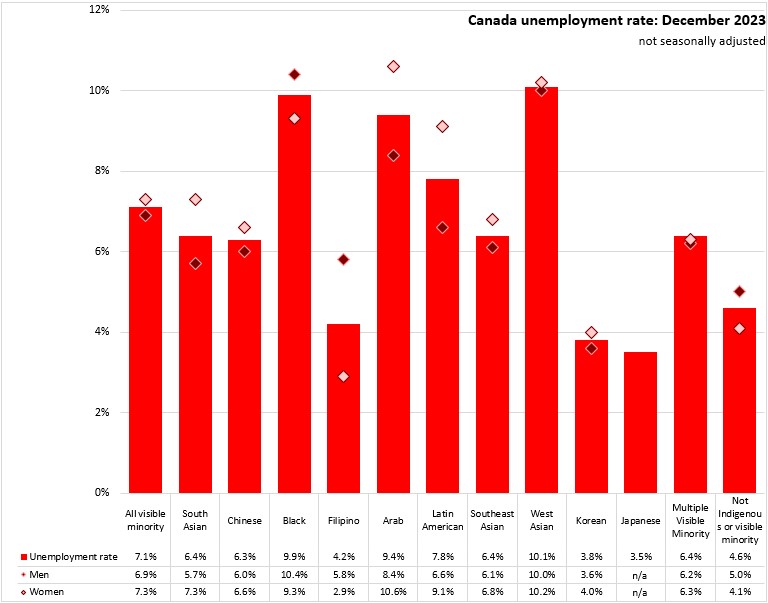
Labour force participation rates for those identifying with a visible minority were generally higher when compared those who do not identify as Indigenous or a visible minority (lower participation rates for Chinese populations). Participation rates were higher for men than for women among all visible minority populations (as well as among those who neither identified as Indigenous nor in a visible minority population).
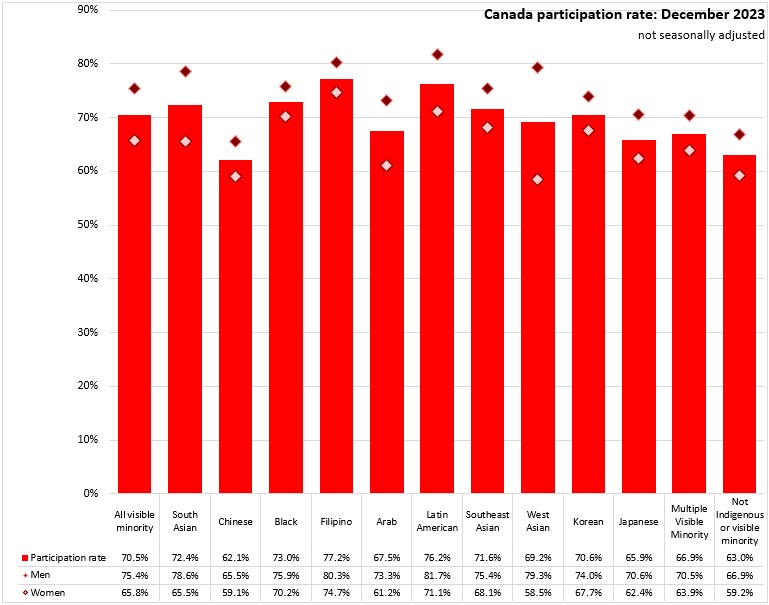
Employment rates were generally higher among visible minority populations than among those who identified neither as Indigenous nor as a visible minority (exception: Chinese populations). Men reported higher employment rates than women in all visible minority populations, as was also the case among populations that did not identify as Indigenous or a visible minority.
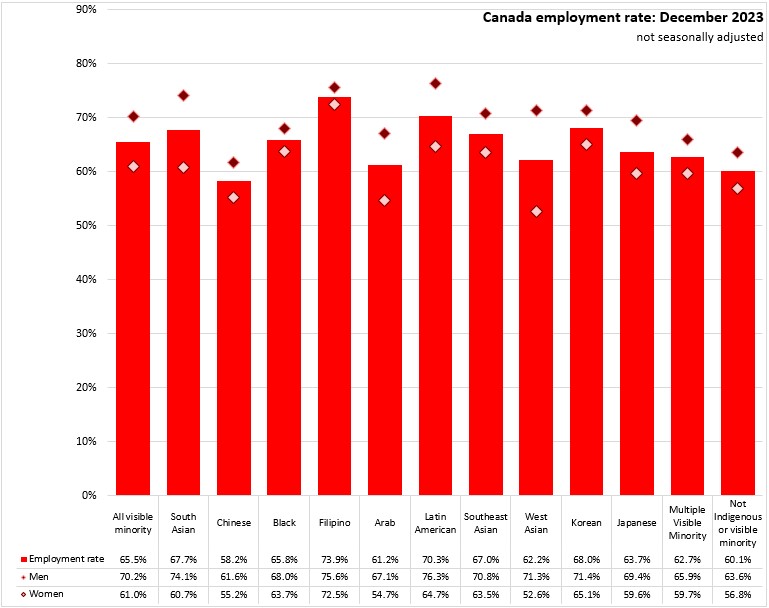
Unemployment rates in Canada were higher for all age cohorts of visible minority populations, when compared with those that do not identify as Indigenous or in a visible minority population. The largest gap was for youth (aged 15-24).
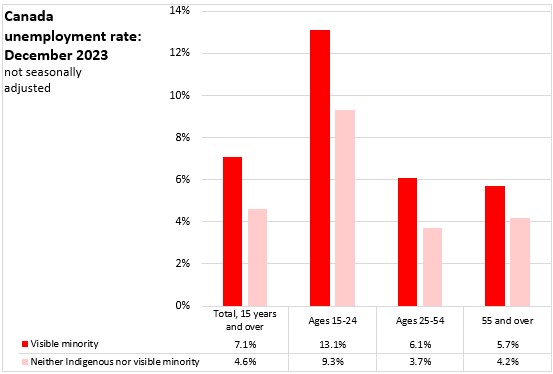
Participation rates of visible minority populations were higher for older workers, compared to the same age cohort that does not identify as Indigenous or visible minority populations. Among youth and core aged workers, participation rates among visible minority populations were lower than among similarly aged populations that do not identify as Indigenous or in a visible minority population.
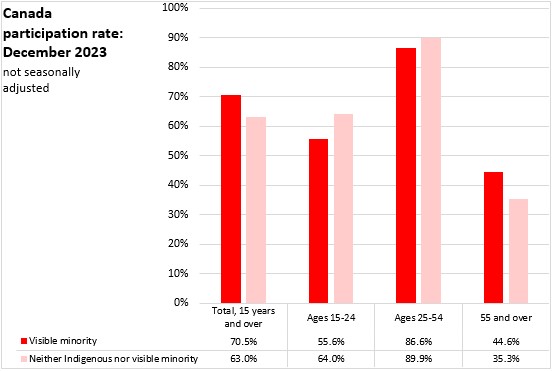
With lower participation and higher unemployment rates, employment rates were lower for visible minority youth and core aged populations than for those who do not identify as Indigenous or a visible minority population. With stronger participation rates (and despite higher unemployment rates), the employment rate of older visible minority populations was higher than older Canadians who do not identify as Indigenous or in a visible minority population.
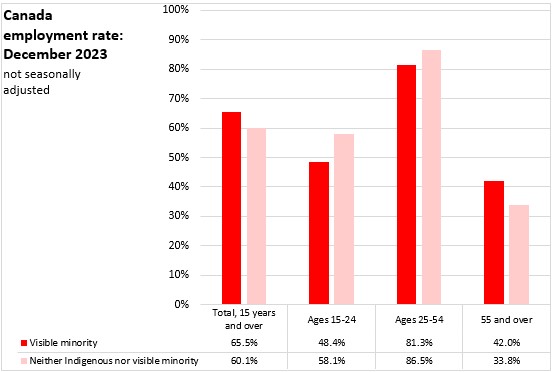
Trends
For the last 7 months, Atlantic Canada unemployment rates for visible minority populations have been higher than for those who identified as neither Indigenous nor in a visible minority population. This reverses the pattern observed through much of 2022 and 2023.
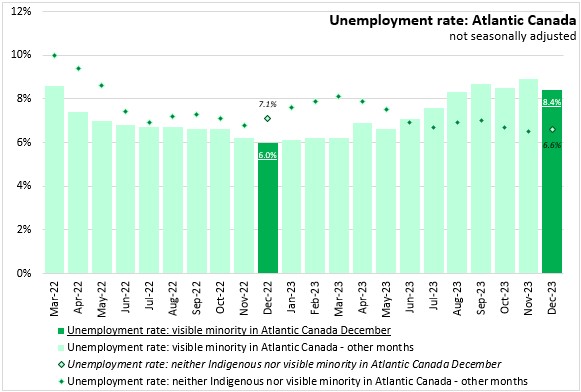
Participation and employment rates for visible minority populations in Atlantic Canada are consistently higher than those that identified neighbor as Indigenous nor in a visible minority population.
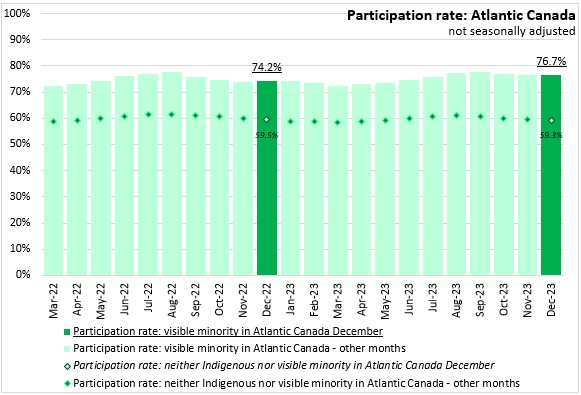
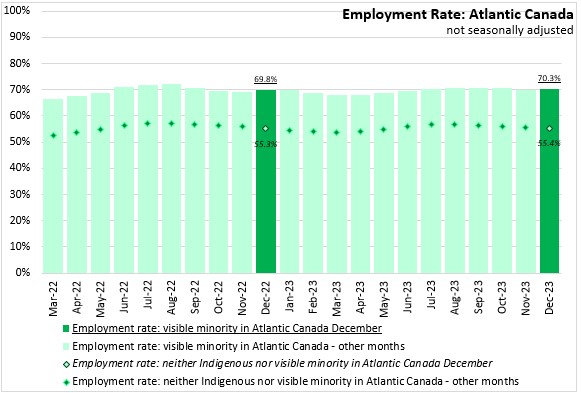
Annual (2023)
Unemployment rates for visible minority populations increased in Canada as well as in all regions except Alberta. The largest increases in visible minority unemployment rates were observed in Québec.
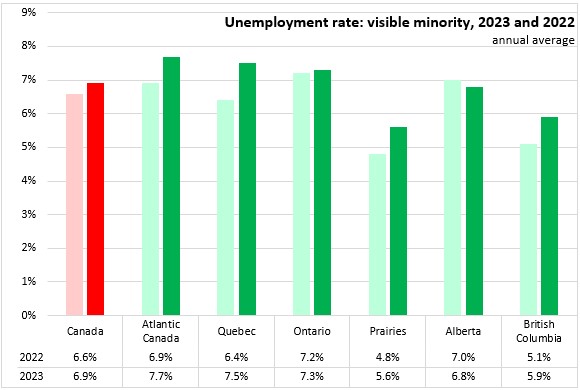
Unemployment rates for populations that identified as neither Indigenous nor a visible minority were unchanged in Canada (as well as in Ontario and the Prairie provinces). In Atlantic Canada and Québec, unemployment rates for those who identified as neither Indigenous nor a visible minority declined in 2023. Unemployment rates for persons that identified as neither Indigenous nor a visible minority were up in Alberta and British Columbia.
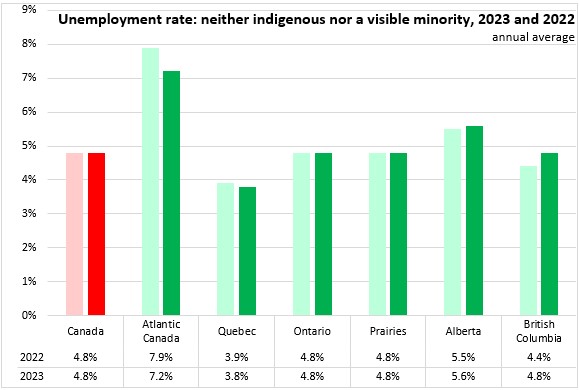
Participation rates for visible minority populations were up across Canada in 2023, reflecting increases in all regions except Ontario (unchanged) and the Prairie provinces (a slight decline).
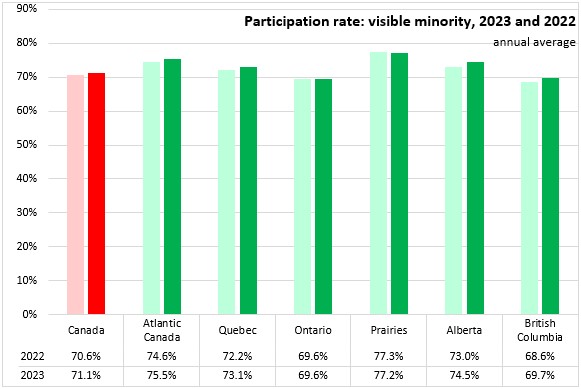
Participation rates for population that identified as neither Indigenous nor a visible minority were little changed across Canada. Gains in Québec offset declines in Atlantic Canada, Alberta and British Columbia (little change in Ontario and the Prairie provinces).
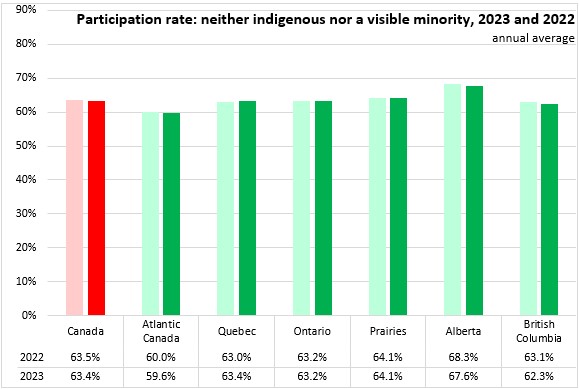
With rising unemployment rates partially offsetting higher participation rates, Canada's employment rate for visible minority populations edged up to 66.2% in 2023. There were small gains in visible minority employment rates in Atlantic Canada, Québec, Alberta and British Columbia (Ontario: no change, Prairie provinces: decline).
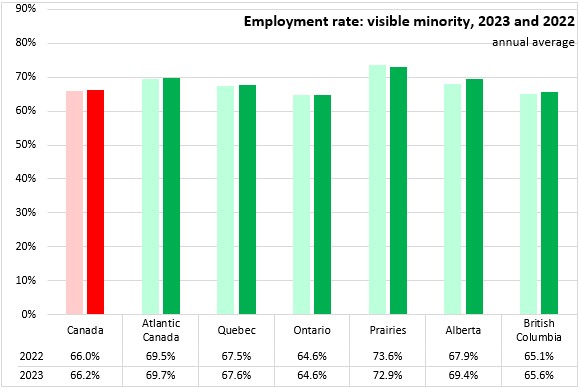
National employment rates for those that identified as neither Indigenous nor in a visible minority population were unchanged at 60.4% in 2023. There were little to no changes in Atlantic Canada, Québec, Ontario and the Prairie provinces. Employment rates for those that identified as neither Indigenous nor in a visible minority population were down in Alberta and British Columbia in 2023.
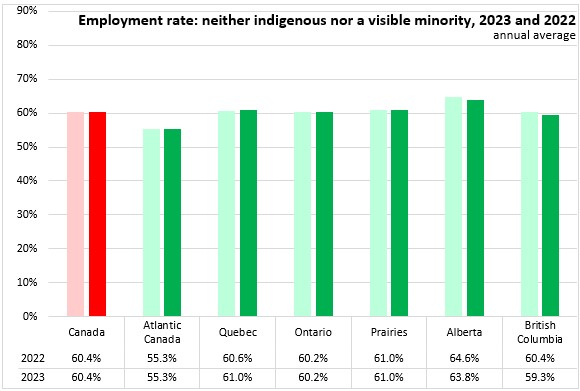
Unemployment rates for most visible minority populations in Atlantic Canada were similar to the averages for the same groups across the country. There were exceptions with higher unemployment rates in Atlantic Canada in the Filipino, Arab, Latin American and Japanese communities (as well as among those that identified as neither Indigenous nor in a visible minority population).
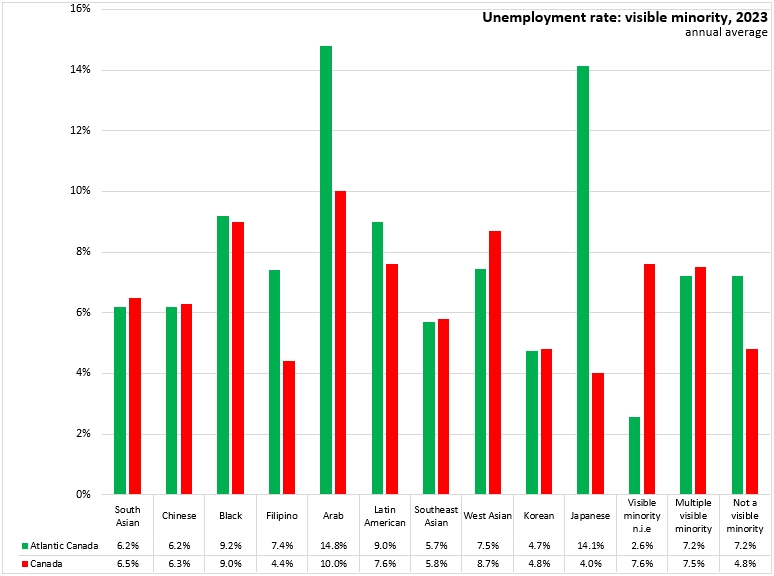
Note that for some suppressed data, the unemployment rate is calculated as 1-(employment rate)/(participation rate).
Participation rates for visible minority groups in Atlantic Canada in 2023 were higher than the national average for South Asian, Chinese, Filipino, Southeast Asian, West Asian and multiple visible minority populations. Participation rates among Atlantic Canada's population that identified as Japanese were notably lower than for Canada's population that identifies as Japanese. Atlantic Canada's participation rates for those that identified as neither Indigenous nor in a visible minority population were lower than comparable national participation rates.
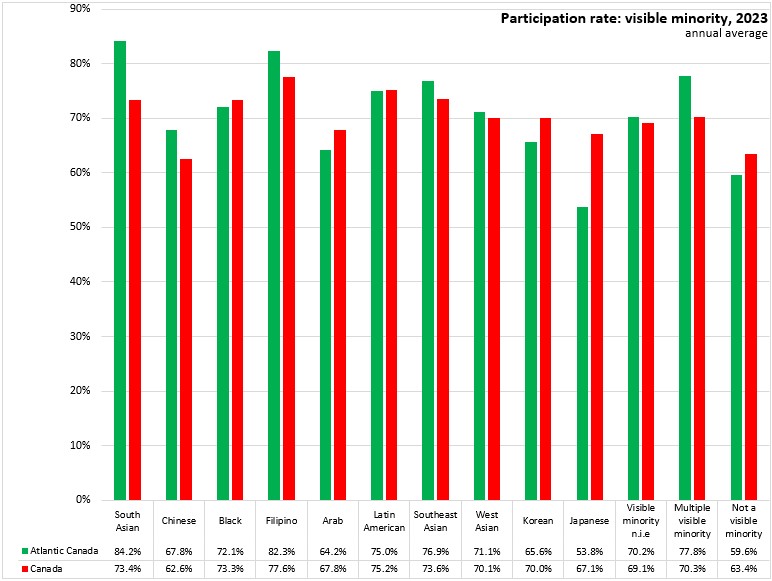
Atlantic Canada employment rates for those that identified as South Asian, Chinese, Filipino, Southeast Asian, West Asian and multiple visible minorities were higher than national averages for similar populations. The markedly lower participation rate for Atlantic Canadians that identify as Japanese translated into a lower employment rate for this group (when compared to the national average for persons that identify as Japanese). Atlantic Canada's employment rates for those that identified as neither Indigenous nor in a visible minority population were lower than comparable national employment rates. 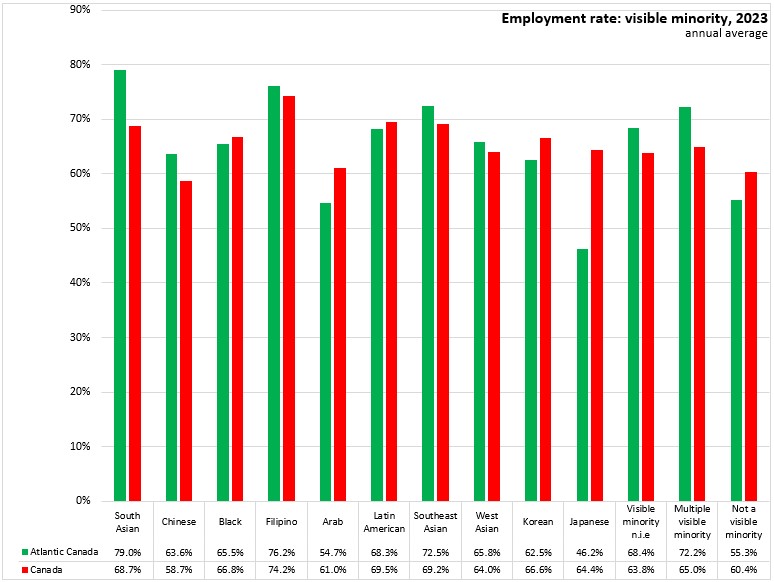
In national data on employment by industry, visible minority employment was disproportionately concentrated in accommodation/food service, health/social/daycare, professional/technical services, finance/insurance/real estate, transportation and manufacturing. Visible minority employment was notably less concentrated in public administration, education, construction and natural resources.
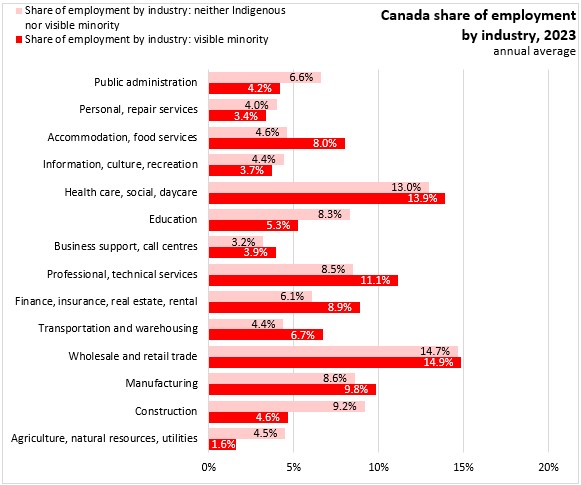
By occupation, visible minority populations were disproportionately concentrated in sales/services, natural/applied sciences, health and manufacturing/utilities. Visible minority populations were disproportionately under-represented in management, education/law/community/government services, trades/transport/equipment operators and natural resources/agriculture occupations.
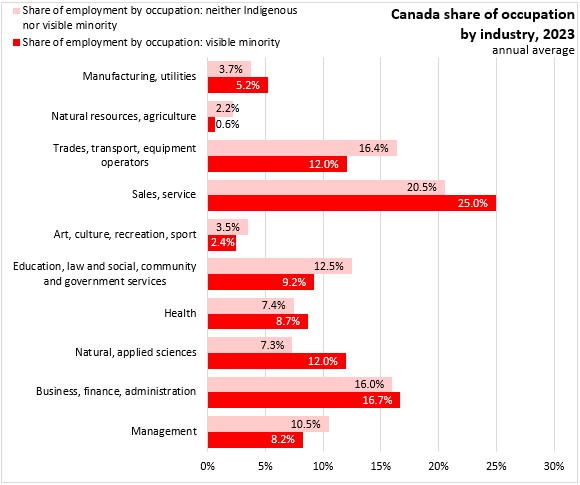
Source: Statistics Canada. Table 14-10-0373-01 Labour force characteristics by visible minority group, three-month moving averages, monthly, unadjusted for seasonality; Table 14-10-0440-01 Labour force characteristics by visible minority group, annual; Table 14-10-0438-01 Employment characteristics by visible minority group, annual
<--- Return to Archive